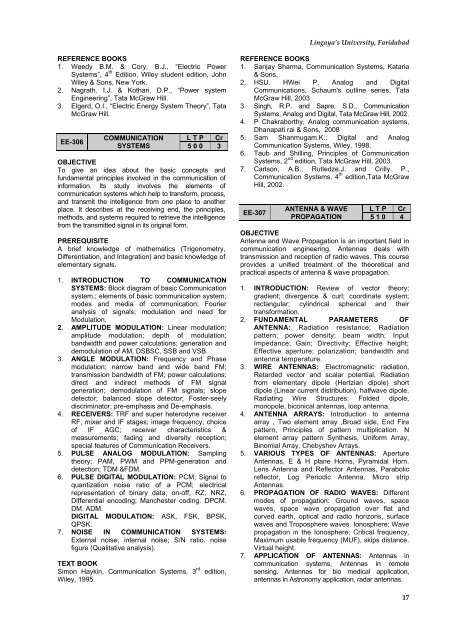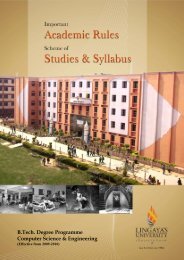Electrical and Electronics - Lingaya's University
Electrical and Electronics - Lingaya's University
Electrical and Electronics - Lingaya's University
Create successful ePaper yourself
Turn your PDF publications into a flip-book with our unique Google optimized e-Paper software.
Lingaya’s <strong>University</strong>, FaridabadREFERENCE BOOKS1. Weedy B.M. & Cory, B.J., ―Electric PowerSystems‖, 4 th Edition, Wiley student edition, JohnWiley & Sons, New York.2. Nagrath. I.J. & Kothari, D.P., ―Power systemEngineering‖, Tata McGraw Hill.3. Elgerd, O.I., ―Electric Energy System Theory‖, TataMcGraw Hill.EE-306COMMUNICATIONSYSTEMSL T P Cr5 0 0 3OBJECTIVETo give an idea about the basic concepts <strong>and</strong>fundamental principles involved in the communication ofinformation. Its study involves the elements ofcommunication systems which help to transform, process,<strong>and</strong> transmit the intelligence from one place to anotherplace. It describes at the receiving end, the principles,methods, <strong>and</strong> systems required to retrieve the intelligencefrom the transmitted signal in its original form.PREREQUISITEA brief knowledge of mathematics (Trigonometry,Differentiation, <strong>and</strong> Integration) <strong>and</strong> basic knowledge ofelementary signals.1. INTRODUCTION TO COMMUNICATIONSYSTEMS: Block diagram of basic Communicationsystem.; elements of basic communication system;modes <strong>and</strong> media of communication; Fourieranalysis of signals; modulation <strong>and</strong> need forModulation.2. AMPLITUDE MODULATION: Linear modulation;amplitude modulation; depth of modulation;b<strong>and</strong>width <strong>and</strong> power calculations; generation <strong>and</strong>demodulation of AM, DSBSC, SSB <strong>and</strong> VSB.3. ANGLE MODULATION: Frequency <strong>and</strong> Phasemodulation; narrow b<strong>and</strong> <strong>and</strong> wide b<strong>and</strong> FM;transmission b<strong>and</strong>width of FM; power calculations;direct <strong>and</strong> indirect methods of FM signalgeneration; demodulation of FM signals; slopedetector; balanced slope detector; Foster-seelydiscriminator; pre-emphasis <strong>and</strong> De-emphasis.4. RECEIVERS: TRF <strong>and</strong> super heterodyne receiverRF, mixer <strong>and</strong> IF stages; image frequency; choiceof IF AGC; receiver characteristics &measurements; fading <strong>and</strong> diversity reception;special features of Communication Receivers.5. PULSE ANALOG MODULATION: Samplingtheory; PAM, PWM <strong>and</strong> PPM-generation <strong>and</strong>detection; TDM &FDM.6. PULSE DIGITAL MODULATION: PCM; Signal toquantization noise ratio of a PCM; electricalrepresentation of binary data; on-off, RZ, NRZ,Differential encoding; Manchester coding. DPCM.DM. ADM.DIGITAL MODULATION: ASK, FSK, BPSK,QPSK.7. NOISE IN COMMUNICATION SYSTEMS:External noise; internal noise; S/N ratio. noisefigure (Qualitative analysis).TEXT BOOKSimon Haykin, Communication Systems, 3 rd edition,Wiley, 1995.REFERENCE BOOKS1. Sanjay Sharma, Communication Systems, Kataria& Sons.2. HSU. HWei P, Analog <strong>and</strong> DigitalCommunications, Schaum's outline series, TataMcGraw Hill, 20033. Singh, R.P. <strong>and</strong> Sapre, S.D., CommunicationSystems, Analog <strong>and</strong> Digital, Tata McGraw Hill, 2002.4. P Chakraborthy, Analog communication systems,Dhanapati rai & Sons, 20085. Sam Shanmugam.K.; Digital <strong>and</strong> AnalogCommunication Systems, Wiley, 1998.6. Taub <strong>and</strong> Shilling, Principles of CommunicationSystems, 2 nd edition, Tata McGraw Hill, 2003.7. Carlson, A.B.; Rutledze.J. <strong>and</strong> Crilly. P.,Communication Systems, 4 th edition,Tata McGrawHill, 2002.EE-307ANTENNA & WAVEPROPAGATIONL T P Cr5 1 0 4OBJECTIVEAntenna <strong>and</strong> Wave Propagation is an important field incommunication engineering. Antennas deals withtransmission <strong>and</strong> reception of radio waves. This courseprovides a unified treatment of the theoretical <strong>and</strong>practical aspects of antenna & wave propagation.1. INTRODUCTION: Review of vector theory;gradient; divergence & curl; coordinate system;rectangular; cylindrical spherical <strong>and</strong> theirtransformation.2. FUNDAMENTAL PARAMETERS OFANTENNA: Radiation resistance; Radiationpattern; power density; beam width; InputImpedance; Gain; Directivity; Effective height;Effective aperture; polarization; b<strong>and</strong>width <strong>and</strong>antenna temperature.3. WIRE ANTENNAS: Electromagnetic radiation,Retarded vector <strong>and</strong> scalar potential, Radiationfrom elementary dipole (Hertzian dipole) shortdipole (Linear current distribution), halfwave dipole.Radiating Wire Structures: Folded dipole,monopole, biconical antennas, loop antenna.4. ANTENNA ARRAYS: Introduction to antennaarray , Two element array ,Broad side, End Firepattern, Principles of pattern multiplication. Nelement array pattern Synthesis, Uniform Array,Binomial Array, Chebyshev Arrays.5. VARIOUS TYPES OF ANTENNAS: ApertureAntennas, E & H plane Horns, Pyramidal Horn.Lens Antenna <strong>and</strong> Reflector Antennas, Parabolicreflector, Log Periodic Antenna, Micro stripAntennas.6. PROPAGATION OF RADIO WAVES: Differentmodes of propagation: Ground waves, spacewaves, space wave propagation over flat <strong>and</strong>curved earth, optical <strong>and</strong> radio horizons, surfacewaves <strong>and</strong> Troposphere waves. Ionosphere; Wavepropagation in the Ionosphere; Critical frequency,Maximum usable frequency (MUF), skips distance.Virtual height.7. APPLICATION OF ANTENNAS: Antennas incommunication systems, Antennas in remotesensing, Antennas for bio medical application,antennas in Astronomy application, radar antennas.17
















